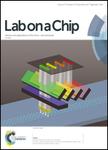版权所有:内蒙古大学图书馆 技术提供:维普资讯• 智图
内蒙古自治区呼和浩特市赛罕区大学西街235号 邮编: 010021

作者机构:Univ Utrecht Debye Inst Nanomat Sci Condensed Matter & Interfaces Princetonpl 1 NL-3584 CC Utrecht Netherlands Univ Twente MESA Inst Nanotechnol Lab On A Chip Grp BIOS POB 217 Enschede Netherlands Univ Twente MESA Inst Nanotechnol Phys Fluids POB 217 Enschede Netherlands Univ Utrecht Debye Inst Nanomat Sci Inorgan Chem & Catalysis Princetonpl 1 NL-3584 CC Utrecht Netherlands Univ Utrecht Debye Inst Nanomat Sci Soft Condensed Matter Princetonpl 1 NL-3584 CC Utrecht Netherlands
出 版 物:《LAB ON A CHIP》 (芯片实验室)
年 卷 期:2019年第19卷第7期
页 面:1236-1246页
核心收录:
学科分类:0710[理学-生物学] 07[理学] 0804[工学-仪器科学与技术] 0805[工学-材料科学与工程(可授工学、理学学位)] 0703[理学-化学]
基 金:Netherlands Center for Multiscale Catalytic Energy Conversion (MCEC) an NWO Gravitation programme - Ministry of Education Culture and Science of the government of the Netherlands
主 题:Spatial resolution Temperature control Electrophoresis Microfluidics spot size confocal microscopy Temperature Fiber optics Lab-On-A-Chip Devices resistance thermometers Thermometry Temperature Sensor Device Component Microfluidic Devices
摘 要:Temperature control for lab-on-a-chip devices has resulted in the broad applicability of microfluidics to, e.g., polymerase chain reaction (PCR), temperature gradient focusing for electrophoresis, and colloidal particle synthesis. However, currently temperature sensors on microfluidic chips either probe temperatures outside the channel (resistance temperature detector, RTD) or are limited in both the temperature range and sensitivity in the case of organic dyes. In this work, we introduce ratiometric bandshape luminescence thermometry in which thermally coupled levels of Er3+ in NaYF4 nanoparticles are used as a promising method for in situ temperature mapping in microfluidic systems. The results, obtained with three types of microfluidic devices, demonstrate that temperature can be monitored inside a microfluidic channel accurately (0.34 degrees C) up to at least 120 degrees C with a spot size of ca. 1 mm using simple fiber optics. Higher spatial resolution can be realized by combining luminescence thermometry with confocal microscopy, resulting in a spot size of ca. 9 m. Further improvement is anticipated to enhance the spatial resolution and allow for 3D temperature profiling.